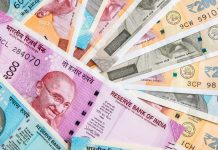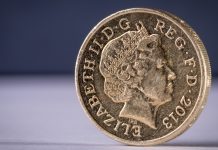The pound spent much of the previous session trading at US$1.33 versus the dollar. However, the headlines on the new top candidate for the US Federal Reserve Chair and concerns over a catastrophic breakdown in Brexit talks, sent the pound US dollar exchange rate to US$1.3232.
| What do these figures mean? |
|---|
|
When measuring the value of a pair of currencies, one set equals 1 unit and the other shows the current equivalent. As the market moves, the amount will vary from minute to minute. For example, it could be written: 1 GBP = 1.28934 USD Here, £1 is equivalent to approximately $1.29. This specifically measures the pound’s worth against the dollar. If the US dollar amount increases in this pairing, it’s positive for the pound. Or, if you were looking at it the other way around: 1 USD = 0.77786 GBP In this example, $1 is equivalent to approximately £0.78. This measures the US dollar’s worth versus the British pound. If the sterling number gets larger, it’s good news for the dollar. |
UK Prime Minister Theresa May has been focusing on a diplomatic push to get Brexit talks moving forward once again. May has reportedly spoken to German Chancellor Angela Merkel, French President Emmanuel Macron and Irish Prime Minister Leo Varadkar in an attempt to get them to soften their stance prior to the EU leaders summit on Thursday. The group of EU leaders are expected to declare that not enough progress has been made on the Brexit divorce bill, to progress to Brexit transition or trade deal talks.
News that Brexit talks are heading towards a catastrophic breakdown unless the EU allows trade talks is unnerving pound traders, who are rapidly selling sterling. If the talks break down then a hard Brexit with no transition deal will be the type of Brexit the UK would face. This will be a very difficult transition for UK businesses and heavily impact the UK economy.
| Why is a “soft” Brexit better for sterling than a “hard” Brexit? |
|---|
| A soft Brexit implies anything less than UK’s complete withdrawal from the EU. For example, it could mean the UK retains some form of membership to the European Union single market in exchange for some free movement of people, i.e. immigration. This is considered more positive than a “hard” Brexit, which is a full severance from the EU. The reason “soft” is considered more pound-friendly is because the economic impact would be lower. If there is less negative impact on the economy, foreign investors will continue to invest in the UK. As investment requires local currency, this increased demand for the pound then boosts its value. |
Today, attention will turn towards UK economic data. Analysts are forecasting that inflation in the form of the consumer price index (CPI) is going to increase to 3% in September. This would be ahead of the Bank of England’s 2% target for inflation and will continue to make monetary policy makers uncomfortable. CPI is an index that measures prices in consumer goods and services such as food and health care produced and offered in a country.
Last month, the central bank gave the biggest hint in a decade that it could consider raising interest rates in November, in order to address Britain’s rising inflation. A high inflation reading today would therefore boost the odds of an interest rate rise, which could in turn send sterling higher.
Top Fed Chair Candidate Boosts Dollar
The dollar was enjoying headlines that Stanford University economist John Taylor has become the top candidate to replace Janet Yellen at the head of the Federal Reserve. Investors are considering this to be a positive development for the US dollar. This is because Taylor has said that he agrees with Fed Chair Janet Yellen’s strategy of gradually removing economic stimulus. Therefore, the markets are seeing him as a more aggressive candidate, meaning interest rate are likely to increase.
| Why do raised interest rates boost a currency’s value? |
|---|
| Interest rates are key to understanding exchange rate movements. Those who have large sums of money to invest want the highest return on their investments. Higher interest rate environments tend to offer higher yields. So, if the interest rate or at least the interest rate expectation of a country is relatively higher compared to another, then it attracts more foreign capital investment. Large corporations and investors need local currency to invest. More local currency used then boosts the demand of that currency, pushing the value higher. |
|
This article was initially published on TransferWise.com from the same author. The content at Currency Live is the sole opinion of the authors and in no way reflects the views of TransferWise Inc. |





